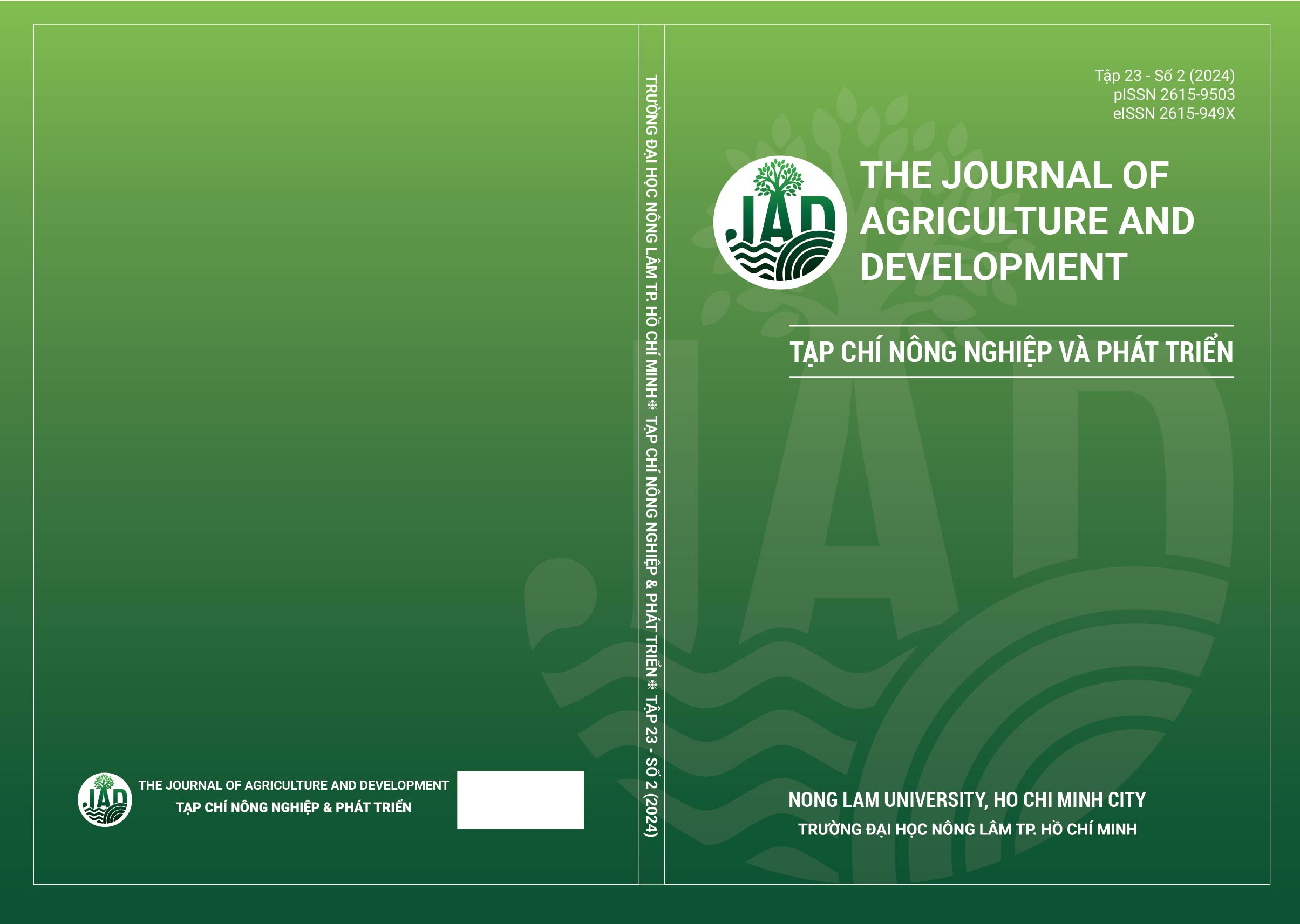Xác định khả năng kháng khuẩn dịch đạm thuỷ phân của nhộng ruồi lính đen (Hermetia illucens) lên một số chủng vi khuẩn gây bệnh trên cá nuôi nước ngọt
Main Article Content
Tóm tắt
Nghiên cứu được thực hiện nhằm xác định khả năng kháng khuẩn của dịch đạm thuỷ phân từ nhộng ruồi lính đen (Hermetia illucens) (ĐTPNRLĐ) lên một số chủng vi khuẩn gây bệnh trên cá nuôi nước ngọt bao gồm E. ictaluri, A. hydrophila, A. verroni, và S. agalactiae. Kết quả cho thấy các chủng vi khuẩn trên nhạy cảm với dịch ĐTPBSF với đường kính vòng kháng khuẩn khác biệt có ý nghĩa về mặt thống kê (P < 0,05) so với đối chứng âm ở các nồng độ thử nghiệm là 20, 35, và 70 mg/100 µL. Cụ thể, E. ictaluri nhạy cảm ở cả ba nồng độ thử nghiệm với vòng kháng khuẩn lần lượt là 14,0 ± 1, 18,7 ± 0,7, và 20,7 ± 0,7 mm. A. veronii và S. agalactiae nhạy ở nồng độ 35 và 70 mg/100 µL, và A. hydrophila với vòng kháng khuẩn 14,3 ± 0,3 mm ở nồng độ 70 mg/100 µL. Dịch đạm thuỷ phân từ nhộng ruồi lính đen có khả năng diệt được A. veronii và S. agalactiae với giá trị MIC (minimum inhibitory concentration) = MBC (minimum bactericidal concentration) = 44 mg/mL, trong khi đó E. ictaluri và A. hydrophila bị ức chế ở MIC 44 mg/mL và MBC là 88 mg/mL. Kết quả này chứng tỏ rằng ĐTPNRLĐ có khả năng được sử dụng để phòng và trị bệnh trên cá do các chủng vi khuẩn E. ictaluri, A. hydrophila, A. verroni, và S. agalactiae gây ra.
Article Details
Tài liệu tham khảo
Abduh, M. Y., Prawitasari, D. A., Fitrian, U. A., & Firmansyah, M. (2023). Effects of enzymatic hydrolysis on the antioxidant activity of protein hydrolysate derived from the larvae of black soldier fly (Hermetia illucens). Journal of Applied Biology and Biotechnology 11(2), 151-157. https://doi.org/10.7324/JABB.2023.110215.
Banks, I. J., Gibson, W. T., & Cameron, M. M. (2014). Growth rates of black soldier fly larvae fed on fresh human faeces and their implication for improving sanitation. Tropical Medicine International Health 19(1), 14-22. https://doi.org/10.1111/tmi.12228.
Canillac, N., & Mourey, A. (2001). Antibacterial activity of the essential oil of picea excelsa on listeria, Staphylococcus aureus and coliform bacteria. Food Microbiology 18(3), 261-268. https://doi.org/10.1006/fmic.2000.0397.
Chen, Y., Chi, S., Zhang, S., Dong, X., Yang, Q., Liu, H., & Xie, S. (2021). Evaluation of the dietary black soldier fly larvae meal (Hermetia illucens) on growth performance, intestinal health, and disease resistance to Vibrio parahaemolyticus of the Pacific White Shrimp (Litopenaeus vannamei). Frontiers in Marine Science 8, 706463. https://doi.org/10.3389/fmars.2021.706463.
Choi, W. H., Choi, H. J., Goo, T. W., & Quan, F. S. (2018). Novel antibacterial peptides induced by probiotics in Hermetia illucens (Diptera: Stratiomyidae) larvae. Entomological Research 48(4), 237-247. https://doi.org/10.1111/1748-5967.12259.
Čičková, H., Newton, G. L., Lacy, R. C., & Kozánek, M. (2015). The use of fly larvae for organic waste treatment. Waste Management 35, 68-80. https://doi.org/10.1016/j.wasman.2014.09.026.
Crumlish, M., Dung, T. T., Turnbull, J. F., Ngoc, N. T. N., & Ferguson, H. W. (2002). Identification of Edwardsiella ictaluri from diseased freshwater catfish, Pangasius hypophthalmus (Sauvage), cultured in the Mekong Delta, Vietnam. Journal of Fish Diseases 25(12), 733-736. https://doi.org/10.1046/j.1365-2761.2002.00412.x.
Ehsan, R., Rahman, A., Paul, S. I., Ador, M. A. A., Haque, M. S., Akter, T., & Rahman, M. M. (2023). Aeromonas veronii isolated from climbing perch (Anabas testudineus) suffering from epizootic ulcerative syndrome (EUS). Aquaculture and Fisheries 8(3), 288-295. https://doi.org/10.1016/j.aaf.2021.11.005.
Elhag, O., Zhou, D., Song, Q., Soomro, A. A., Cai, M., Zheng, L., & Zhang, J. (2017). Screening, expression, purification and functional characterization of novel antimicrobial peptide genes from Hermetia illucens (L.). PloS One 12(1), e0169582. https://doi.org/10.1371/journal.pone.0169582.
Epand, R. M., & Vogel, H. J. (1999). Diversity of antimicrobial peptides and their mechanisms of action. Biochimica et Biophysica Acta (BBA)-Biomembranes 1462(1-2), 11-28. https://doi.org/10.1016/S0005-2736(99)00198-4.
Harlystiarini, H., Mutia, R., Wibawan, I. W. T., & Astuti, D. A. (2019). In vitro antibacterial activity of black soldier fly (Hermetia illucens) larva extracts against gram-negative bacteria. Buletin Peternakan 43(2), 125-129. https://doi.org/10.21059/buletinpeternak.v43i2.42833.
Inglis, V., Roberts, R. J., & Bromage, N. R. (1993). Bacterial diseases of fish. New York, USA: Halsted Press.
Lee, D. H., Chu, K. B., Kang, H. J., Lee, S. H., & Quan, F. S. (2020). Peptides in the hemolymph of Hermetia illucens larvae completely inhibit the growth of Klebsiella pneumonia in vitro and in vivo. Journal of Asia-Pacific Entomology 23(1), 36-43. https://doi.org/10.1016/j.aspen.2019.10.004.
MITV (Ministry of Industry and Trade of Vietnam). (2022). Developing Vietnam’s seafood industry to adapt to the new situation. Retrieved May 20, 2023, from https://moit.gov.vn/tin-tuc/thitruong-trong-nuoc/phat-trien-nganh-thuysan-viet-nam-thich-ung-voi-tinh-hinh-moi.html.








